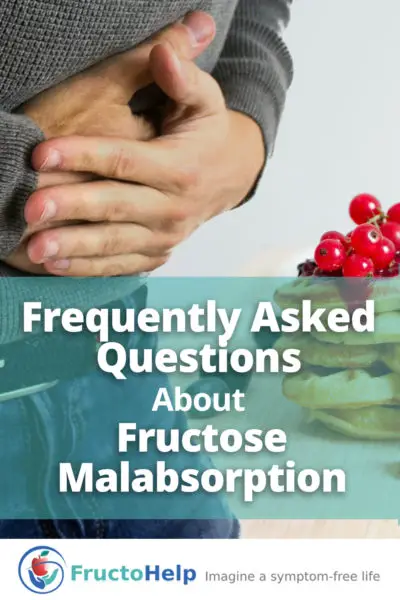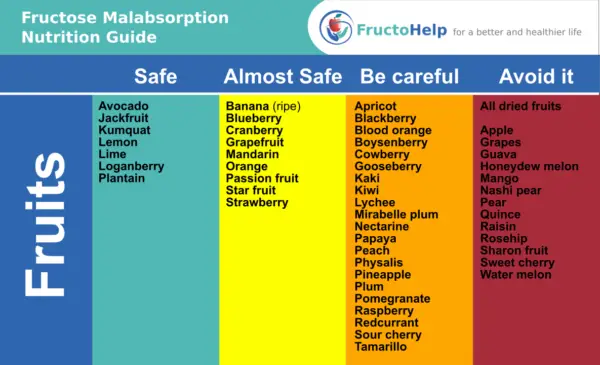
Here are the answers to some of the most frequently asked questions. The most convenient way is to simply ask my new Knowledge AI. It’s trained on every question ever asked and the entire website. Of course, you can also manually search for the answer to your question below.
Disorder specific questions
What happens if you are fructose intolerant?
When having fructose malabsorption, which was formerly named dietary fructose intolerance (DFI) your body can’t absorb fructose very well along its small intestine. Remaining fructose that reaches the colon gets fermented by bacteria and causes bloating, cramps, pain, and diarrhea.
In contrast, hereditary fructose intolerance (HFI) is a genetic disorder where the liver is not able to help breaking down the fructose, which can lead to severe toxic symptoms, such as tremors, vomiting, and disorientation, after fructose ingestion.
What does fructose malabsorption feel like?
Having fructose malabsorption means getting symptoms like bloating, cramps, stomach ache, and diarrhea after almost any meals, when not knowing which foods are safe. Brain fog and sudden mood swings can also happen. Symptoms occur typically after eating sweet food, fruits, food with lots of spices, onions or garlic. Read more about common symptoms and why even depression can be a consequence of fructose malabsorption on my Fructose Malabsorption Facts page.
Can you develop fructose malabsorption?
Fructose malabsorption can develop due to a bad diet, such as eating too much fructose-rich foods, environmental pollution, chronic stress, inflammation, an imbalance of bacteria in your gut, or preexisting gut issues.
How do you know if you have fructose malabsorption?
If you are suffering from bloating, cramps, or diarrhea after consuming foods with fructose this may be a sign of fructose malabsorption. But symptoms can vary from person to person as well as the tolerable amount of fructose. So, you can’t know for certain that you have it until you have made a professional hydrogen breath test. First, you will have to consume a certain amount of fructose. Then breaths samples are taken during the next three hours. If the amount of hydrogen rises above a certain treshhold it indicates that your body has problems in absorbing fructose properly.
Does fructose malabsorption cause weight gain?
Symptoms of fructose malabsorption are typically bloating, cramps, stomach ache, and diarrhea. As a consequence of diarrhea and the fact that less fructose gets absorbed and that fructose malabsorption affects the joy of eating, weight loss is more likely a consequence of fructose malabsorption than weight gain.
How do you manage fructose malabsorption?
Dealing with fructose malabsorption requires knowledge of the foods to avoid, following a strict diet and keeping a food diary to find your own thresholds and foods that are still tolerable. You can also add the enzyme xylose isomerase to fructose-rich food for balancing out fructose and glucose or consume glucose simultaneously with fructose, as it acts as piggyback transporter.
Does fructose malabsorption go away?
Unfortunately, there is no simple cure to fructose malabsorption. But a proper diet and the supplementation of the enzyme xylose isomerase can help to improve the symptoms significantly. Some people also reported that they could restore normal gut function after months or sometimes years of following a strict diet. This website will show you how to manage fructose malabsorption successfully and avoid common mistakes.
What enzymes break down fructose?
Fructose can be broken down by the enzyme xylose isomerase, which is not made by the human body but can be bought as a supplement to avoid symptoms of fructose malabsorption when eating food with excess fructose.
This enzyme leads to a balance between glucose and fructose, as it converts excess fructose into glucose and vice versa. As glucose acts as a piggyback transport for fructose a balanced ratio leads to improved symptoms. Read more about xylose isomerase, how it works, and where to get it on my Fructose Malabsorption Medication page.
Are fructans the same as fructose?
Fructans and fructose are both FODMAPs, but they are quite different. Fructans are polysaccharides consisting of several short chains of the monosaccharide fructose. They are called fructooligosaccharides when they consist of 2-9 fructose units, and inulins when having more than 10 units. Foods that have high amounts of fructans are onions, garlic, and artichokes.
Our body doesn’t have enzymes for breaking down fructans. This means, that fructans get fermented in the large intestine even in healthy individuals, which results in variable amounts of gas. For those with fructose malabsorption fructans can worsen symptoms drastically and should be strictly avoided.
Further food-specific questions
Are cherries high in fructose?
Besides all dried fruits, apples, watermelon, pears, grapes, and mangos, cherries belong to the high fructose fruits. They contain up to 6.14g fructose per 100g and also high amounts of sorbitol. People with fructose malabsorption should avoid them, as such amounts fructose and sorbitol content will induce symptoms like bloating, discomfort, and diarrhea.
Are blueberries high in fructose?
Blueberries do have a moderate amount of fructose (about 3.34g per 100g), but also a fructose to glucose ratio of 1.36. For people with fructose malabsorption, this means there is some excess fructose that won’t be absorbed in the small intestine and may cause symptoms of bloating and discomfort. The same goes for bananas, strawberries, and oranges. Small amounts may be tolerable. Larger amounts will probably cause symptoms.
Read more about why the fructose to glucose ratio is important on my Fructose Malabsorption Facts page.
Do grapes have fructose?
Grapes have a high amount of fructose (up to 7.44g per 100g) and, thus, belong to the high-fructose fruits. Amongst them are all dried fruits, apples, grapes, guavas, nashi pears, pears, sharon fruits, sweet cherries, and watermelons. People with fructose malabsorption, which was formerly named fructose intolerance, should avoid these fruits.
Does sweet potato have fructose?
Sweet potatoes have about 0.7g fructose per 100g. That’s only about 0.5g more than common potatoes. However, they should be treated with caution when having fructose malabsorption. See also my Fructose Malabsorption Food List for further details about which foods to avoid or being careful with.
Does onion have fructose?
Onions contain a moderate amount of fructose (up to 2.4g per 100g). But they also contain high amounts of fructans, which can cause bloating and discomfort in people suffering from fructose malabsorption. They should be avoided when being on a low fructose diet or when symptoms get triggered.
Does brown sugar have fructose?
Brown sugar is refined white sugar with some amounts of molasses, ranging from 4.5% to 6.5%. Just like cane sugar, raw sugar, and white sugar, brown sugar consists of sucrose, which is 50% fructose and 50% glucose. That’s the reason why people with fructose intolerance should limit or even avoid such sugars.
Does chocolate contain fructose?
Chocolate contains high amounts of sucrose, typically around 50g/100g chocolate. Sucrose is also called table sugar and is a compound of the monosaccharides glucose and fructose. Together they form a disaccharide. When sucrose is consumed, an enzyme in the body separates sucrose into its single sugar units and thereby releases fructose.
Is peanut butter high in fructose?
Peanut butter can contain lots of fructose. Many peanut butter manufacturers make it sweeter by adding sugar or even high fructose corn syrup (HFCS). The same goes for other nut butters, such as almond or cashew butter. So, check the labels carefully before buying one.
What fruits have no fructose?
There is almost no fruit that has no fructose. Plantain and avocado are the ones with the lowest fructose content (0.2g per 100g). But there are quite some low fructose fruits, amongst them are
- Blueberry
- Cactus pear
- Cranberry
- Cantaloupe
- Grapefruit
- Jackfruit
- Lemon
- Lime
- Mandarin
- Orange
- Passion fruit
- Star fruit
- Strawberries
What vegetables have no fructose?
Only a few vegetables contain considerable amounts of fructose, amongst them artichokes, beans, broccoli, cabbage, hot pepper, leek, tomatoes, and onions. All other vegetables have a much lower fructose content.
If you are suffering from fructose malabsorption, please notice, that not only fructose can cause symptoms, but fructans as well. This further reduces the list of tolerable vegetables. Amongst the safe vegetables are kale, spinach, pak choi, and white turnips. Check out this infographic for a full list.
Which foods are high in fructose?
Foods that contain high fructose corn syrup (HFCS) are high in fructose, amongst them are often:
- Soda
- Candy
- Sweetened juice
- Sweetened yogurt
- Cereals
- Salad dressing
- Granola
- Sports and energy drinks
- Ice cream
- Baked goods
- Coffee creamer
- Nutrition bars
- Sauces
- All dried fruits
- Apple
- Kiwi
- Nashi pear
- Pear
- Sweet cherries
- Agave syrup
- Honey
Feel free to ask further questions below. I will be happy to answer and add them to the list.
